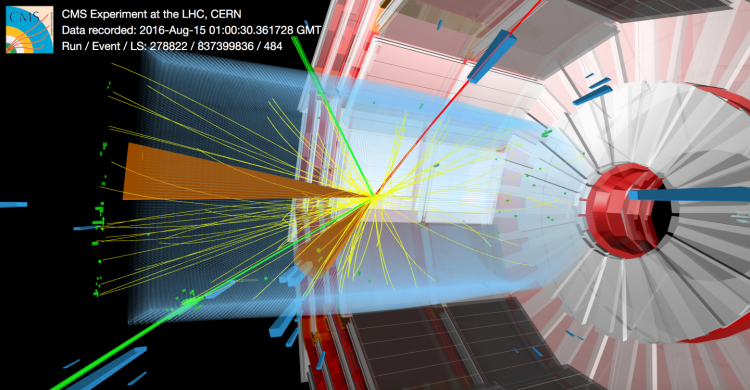
The top quark is the heaviest particle in the standard model, and since its discovery in 1995 at the Tevatron collider at Fermilab, its study has become prominent in furthering our understanding of fundamental physics. At the Large Hadron Collider, most top quarks are produced in pairs through the interactions of quarks and gluons. Production of single top quarks, though more rare than production in pairs, offers a different avenue to study the top quark produced via the electroweak interaction. This makes single top quark production an important signature for studying the properties of the top quark.
Only in the past 10 years physicists have seen the first single top quarks, which were together with a quark (in 2009 by the experiments at Fermilab). Production of single top quarks together with a W boson was first observed by the CMS experiment in 2014, and evidence for the production of single top quarks together with a photon was reported earlier this year. And now for the first time the CMS experiment observes single top quarks produced together with a Z boson. This signature is commonly referred to as tZq because at the LHC the top quark and Z boson are produced together with a light quark.
Single top quark production with a Z boson is a very rare process, and particularly sensitive to effects from physics beyond the standard model. In the standard model, interactions between quarks and Z bosons do not alter the flavor of the quarks involved. A violation of this principle, a so-called flavor changing neutral current, could be a sign of physics beyond the standard model to which the tZq process is particularly sensitive. These unique features, and the addition of complementary information to the global constraints on modified top quark interactions, make tZq an important process to study.

A search for tZq in events with all combinations of three electrons or muons was carried out by the CMS collaboration and has been presented as the LHC seminar at CERN on Tuesday 4 December 2018. The extremely small production rate of tZq events, roughly 50 times smaller than that of the Higgs boson, and the relatively large experimental background from jets mimicking leptons, made observing tZq a formidable challenge. These challenges were overcome through the use of machine learning algorithms to identify the leptons from the top and Z decays. This strategy is similar to what was employed in the recent observation of ttH production, and proved to also greatly improve the search for tZq production.

The outcome of the machine learning algorithm used in this analysis. This distribution shows that tZq production (red) can be separated from other collisions produced at the LHC, and that the data (black points) agrees with the prediction of the standard model if tZq prediction exists.
With the newly optimized analysis strategy and signal selection process, an excess of events attributed to tZq production is observed with a significance well above the commonly agreed convention to claim discovery of 5 standard deviations, equivalent to a probability of much more than one in two million that this result is caused by a statistical fluctuation. The measurement of the production rate of this process is more than twice as accurate as achieved in previous measurements. The paper describing the first observation and measurement of the tZq process will soon be submitted to the journal Physical Review Letters.

A group picture of some of the over 4000 international CMS collaborators, including those involved with the final steps of this result.
While the measured cross section is found to be consistent with the SM, new physics could still make its appearance in future measurements. Measuring the behavior of the particles in tZq production, for example by differential cross section measurements, could unexpected behavior caused by new physics that cannot be observed in the current measurement yet. When the LHC starts its Run 3 in 2021, the newly discovered tZq process will be one of the tools that will provide many opportunities to study the standard model and any physics that lies beyond our current knowledge.
CMS Physics
- This result as a CMS Physics Analysis Summary
- All CMS Papers
- All CMS Physics Analysis Summaries
- All CMS results
- Images of real collisions in CMS
- Follow @CMSpapers on Twitter
About CMS
More information: cms.cern, or contact: cms.outreach@cern.ch.
CMS is one of two general-purpose experiments at the LHC that have been built to search for new physics. It is designed to detect a wide range of particles and phenomena produced in the LHC's high-energy proton-proton and heavy-ion collisions and will help to answer questions such as: "What is the Universe really made of and what forces act within it?" and "What gives everything mass?" It will also measure the properties of well-known particles with unprecedented precision and be on the lookout for completely new, unpredicted phenomena. Such research not only increases our understanding of the way the Universe works, but may eventually spark new technologies that change the world in which we live as has often been true in the past.
The conceptual design of the CMS experiment dates back to 1992. The construction of the gigantic detector (15 m diameter by nearly 29 m long with a weight of 14000 tonnes) took 16 years of effort from one of the largest international scientific collaborations ever assembled: more than 4000 physicists (including 1500 students) plus 700 engineers and technicians, from around 200 institutions and research laboratories distributed in more than 40 countries all over the world.
- Log in to post comments

